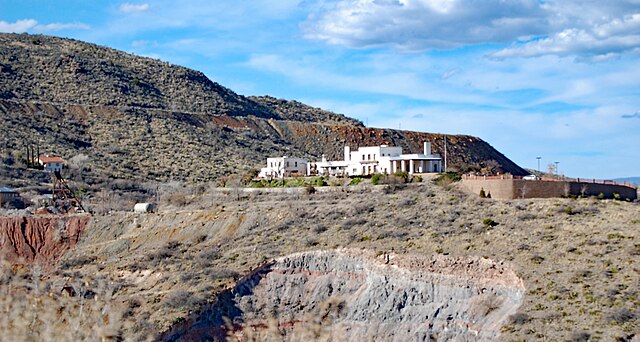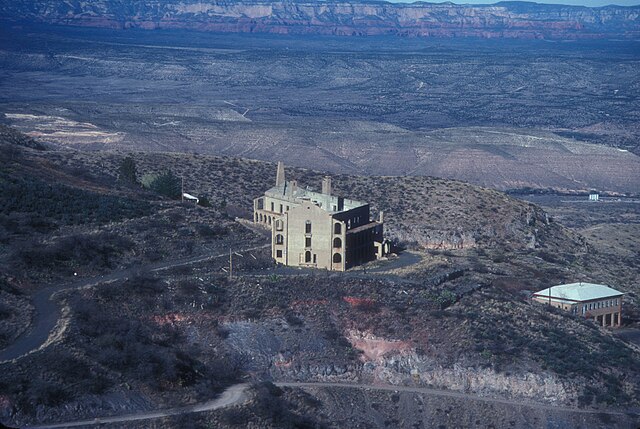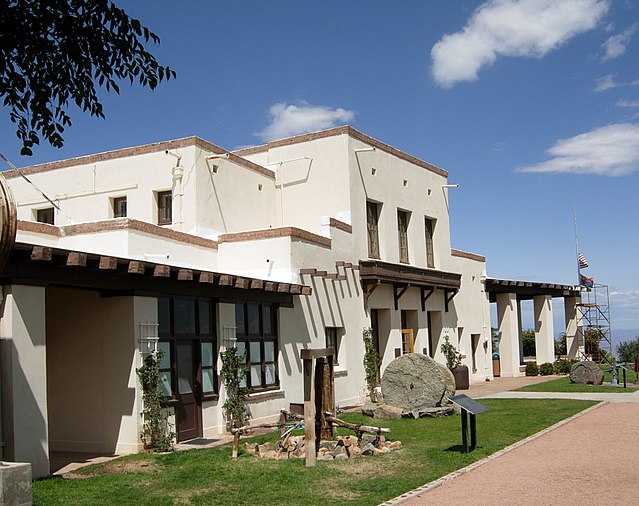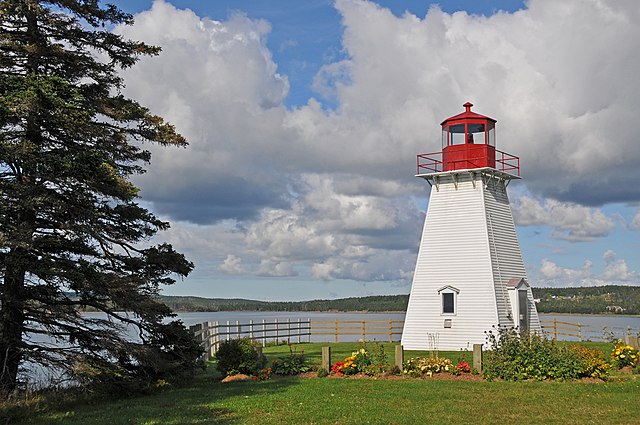Perched dramatically on the slopes of Mingus Mountain, Jerome State Historic Park stands as a testament to Arizona’s wild mining past. This fascinating destination offers visitors a unique glimpse into the boom-and-bust cycle that shaped the American West. Whether you’re a history buff, outdoor enthusiast, or simply looking for an unforgettable Arizona adventure, Jerome State Historic Park delivers an experience that’s both educational and awe-inspiring.
What is Jerome State Historic Park?
Jerome State Historic Park is more than just a preserved piece of Arizona history—it’s a window into the past that brings the Old West to life. Located in the historic mining town of Jerome, this state park centers around the restored Douglas Mansion, which now serves as a museum showcasing the area’s rich copper mining heritage.
Location and Quick Facts
Nestled in the Black Hills of Yavapai County, Jerome State Historic Park sits at an elevation of 5,200 feet above sea level. The park spans several acres and offers breathtaking panoramic views of the Verde Valley below. This unique location provides visitors with both historical insights and spectacular natural beauty.
The park is managed by Arizona State Parks and Trails, ensuring that this precious piece of Arizona heritage remains accessible to future generations. It’s strategically positioned to offer some of the most stunning vistas in central Arizona, making it a photographer’s paradise and a must-visit destination for anyone exploring the region.
Historical Significance
Jerome State Historic Park preserves the legacy of what was once known as the “Wickedest Town in the West.” During its heyday, Jerome was a bustling mining community that produced over one billion dollars worth of copper, gold, and silver. The park serves as a crucial link to understanding Arizona’s mining history and the people who risked everything to strike it rich in the unforgiving desert landscape.
The significance of this location extends beyond mining history. It represents the American dream, the spirit of entrepreneurship, and the challenges faced by early settlers in the Southwest. Today, the park continues to educate visitors about these important historical themes while preserving the physical structures that tell this compelling story.
The Rich History of Jerome State Historic Park

The story of Jerome State Historic Park is intrinsically linked to the broader narrative of American westward expansion and the mining boom that defined much of the 19th and early 20th centuries. Understanding this history enhances any visit to the park and provides context for the exhibits and structures you’ll encounter.
The Mining Boom Era
Jerome’s mining history began in the 1870s when prospectors discovered rich copper deposits in the Black Hills. The United Verde Copper Company, founded by William A. Clark, transformed Jerome from a small mining camp into one of Arizona’s most prosperous communities. At its peak in the 1920s, Jerome boasted a population of over 15,000 residents, making it one of the largest cities in Arizona Territory.
The mining operations were nothing short of extraordinary. The mines produced not only copper but also significant amounts of gold and silver, contributing to Arizona’s reputation as a mineral-rich state. The town’s strategic location on the mountainside allowed for efficient ore processing and transportation, though it also presented unique challenges that would later contribute to its decline.
Life in boom-era Jerome was characterized by both prosperity and danger. Miners worked in hazardous conditions, and the town’s steep terrain and wooden construction made it vulnerable to fires and landslides. Despite these challenges, Jerome attracted people from around the world, creating a diverse community that included Mexican, Irish, Italian, and Chinese immigrants.
From Boom to Bust
The decline of Jerome began in the 1930s when copper prices fell and the most accessible ore deposits were exhausted. The final blow came in 1953 when Phelps Dodge Corporation closed the mines permanently. Almost overnight, Jerome transformed from a thriving city to a virtual ghost town. The population plummeted to fewer than 50 residents, and many buildings were abandoned or demolished.
This dramatic transformation is part of what makes Jerome State Historic Park so fascinating. It captures a moment in time when the American West was rapidly changing, and mining communities were experiencing the harsh realities of boom-and-bust economics.
The Douglas Mansion Story
Central to Jerome State Historic Park is the Douglas Mansion, built in 1916 by James “Rawhide Jimmy” Douglas Jr., who served as president of the Phelps Dodge Corporation. This impressive structure was designed as both a family residence and a symbol of the mining company’s success and permanence in Jerome.
The mansion’s construction represented the height of Jerome’s prosperity. Built with reinforced concrete to withstand the town’s frequent fires, it featured modern amenities that were luxurious for its time, including electricity, indoor plumbing, and a sophisticated ventilation system. The mansion’s elevated position provided commanding views of the mining operations and the Verde Valley beyond.
When the mines closed, the mansion was donated to Arizona State Parks in 1962, ensuring its preservation for future generations. Today, it serves as the centerpiece of the state park, housing exhibits that tell the story of Jerome’s mining heritage and the people who shaped its history.
What to See and Do at Jerome State Historic Park
Jerome State Historic Park offers visitors a diverse range of experiences that combine historical education with outdoor recreation. The park’s compact size makes it perfect for a half-day visit, though many visitors find themselves spending much longer exploring the various exhibits and enjoying the spectacular views.
Douglas Mansion Museum
The Douglas Mansion Museum is the crown jewel of Jerome State Historic Park. This beautifully restored building houses extensive exhibits that bring Jerome’s mining history to life. As you explore the mansion’s rooms, you’ll discover artifacts, photographs, and interactive displays that tell the story of the town’s rise and fall.
The museum’s layout follows a logical progression through Jerome’s history, beginning with the geological formation of the copper deposits and moving through the various phases of mining operations. Personal stories of miners, their families, and the town’s residents add human interest to the broader historical narrative.
One of the museum’s most compelling features is its collection of mining equipment and tools. These artifacts provide tangible connections to the dangerous and demanding work that defined life in Jerome. The museum also features exhibits on the town’s diverse population, showcasing how people from different cultures contributed to Jerome’s unique character.
Exhibits and Collections
The museum’s permanent collection includes thousands of artifacts ranging from mining equipment to household items used by Jerome’s residents. Highlights include a 1918 Dort automobile, period furniture from the Douglas family, and an extensive collection of photographs documenting daily life in the mining town.
The geology exhibit is particularly fascinating, featuring mineral samples and explanations of the geological processes that created Jerome’s rich copper deposits. Interactive displays help visitors understand how mining operations evolved over time and the technological innovations that made large-scale copper extraction possible.
Rotating exhibits ensure that repeat visitors always have something new to discover. These temporary displays often focus on specific aspects of Jerome’s history, such as the role of women in the mining community or the town’s multicultural heritage.
Hiking Trails and Outdoor Activities
While the museum is the park’s main attraction, outdoor enthusiasts will find plenty to explore in the surrounding area. The park offers several walking trails that provide different perspectives on Jerome’s history and geography.
The Auditorium Trail is a gentle walk that leads to the ruins of Jerome’s old auditorium, where miners and their families once gathered for entertainment and community events. This trail offers excellent views of the Verde Valley and helps visitors understand the town’s layout during its heyday.
For those seeking more challenging terrain, the park connects to several longer hiking trails in the surrounding Prescott National Forest. These trails offer opportunities to explore the natural environment that surrounded the mining operations and to appreciate the challenging conditions faced by Jerome’s early residents.
Scenic Viewpoints
Jerome State Historic Park is renowned for its spectacular views, and several designated viewpoints within the park offer perfect spots for photography and contemplation. The main viewpoint near the Douglas Mansion provides a 360-degree panorama that includes the Verde Valley, Sedona’s red rocks, and the distant San Francisco Peaks.
These viewpoints are particularly stunning during sunrise and sunset when the desert landscape is bathed in golden light. The elevation and clear desert air make for excellent visibility, often allowing visitors to see for miles across the Arizona landscape.
The park’s elevated position also provides unique perspectives on Jerome’s remaining buildings and the terraced mountainside that bears the scars of decades of mining operations. These viewpoints help visitors understand the scale of the mining operations and the dramatic changes they brought to the natural landscape.
Planning Your Visit to Jerome State Historic Park

Proper planning can significantly enhance your experience at Jerome State Historic Park. Understanding the best times to visit, what to expect, and how to make the most of your time will help ensure a memorable and educational experience.
Best Times to Visit
Arizona’s desert climate means that Jerome State Historic Park can be visited year-round, but certain seasons offer distinct advantages. Spring (March through May) and fall (September through November) provide the most comfortable weather conditions, with mild temperatures and clear skies that are perfect for outdoor exploration and photography.
Summer visits can be rewarding but require preparation for hot weather. The park’s elevation provides some relief from the intense heat of lower desert areas, but temperatures can still reach uncomfortable levels during midday hours. Early morning and late afternoon visits are recommended during summer months.
Winter visits offer their own unique appeal, with crisp air and occasional snow creating a dramatically different atmosphere. The park’s elevation means that winter weather can be more severe than in lower desert areas, so visitors should check weather conditions and dress appropriately.
Admission Fees and Hours
Jerome State Historic Park operates on a seasonal schedule, with hours varying depending on the time of year. The park typically opens at 8:00 AM and closes at 5:00 PM, though these hours may be extended during peak visitation periods. It’s always wise to check the Arizona State Parks website for current hours and any special closures.
Admission fees are reasonable and help support the park’s ongoing maintenance and educational programs. Adults pay a standard entrance fee, while children under certain ages may be admitted free. Arizona State Parks passes and America the Beautiful passes are honored, making visits more affordable for frequent park visitors.
Special Events and Programs
Throughout the year, Jerome State Historic Park hosts special events and educational programs that enhance the visitor experience. These may include living history demonstrations, guided tours with park rangers, and special exhibits that coincide with significant anniversaries or historical themes.
During peak tourist seasons, the park often offers expanded programming, including evening tours that take advantage of the area’s excellent stargazing conditions. These programs provide deeper insights into Jerome’s history and help visitors connect more personally with the site’s significance.
Getting to Jerome State Historic Park
Reaching Jerome State Historic Park is part of the adventure, as the journey takes you through some of Arizona’s most scenic landscapes. The park’s location on Highway 89A makes it accessible from several major Arizona cities, though the winding mountain roads require careful driving.
Driving Directions
From Phoenix, the most direct route to Jerome State Historic Park involves taking Interstate 17 north to Highway 260 west, then connecting to Highway 89A north. This journey covers approximately 120 miles and typically takes about 2.5 hours, depending on traffic and road conditions.
Visitors coming from Flagstaff can take Highway 89A south through Oak Creek Canyon and Sedona, a spectacularly scenic route that adds to the overall experience. This approach offers stunning views of red rock formations and provides opportunities to explore other attractions along the way.
The final approach to Jerome involves navigating winding mountain roads that climb dramatically up Mingus Mountain. These roads are generally well-maintained but require careful attention, especially during adverse weather conditions. The dramatic elevation changes and sweeping curves make this journey memorable but potentially challenging for some drivers.
Parking and Accessibility
Jerome State Historic Park provides adequate parking for most visitors, though spaces can fill quickly during peak tourist seasons and special events. The parking area is located near the Douglas Mansion Museum, providing convenient access to the park’s main attractions.
The park has made efforts to improve accessibility, with paved pathways leading to the museum and main viewpoints. However, the historic nature of the site and its mountainous location mean that some areas may be challenging for visitors with mobility limitations. The Douglas Mansion Museum is wheelchair accessible, and park staff are available to provide assistance and information about accessible features.
Nearby Attractions and Activities
Jerome State Historic Park’s location in central Arizona makes it an ideal base for exploring numerous other attractions. The park’s proximity to Sedona, Prescott, and other destinations allows visitors to create comprehensive itineraries that showcase the region’s diverse offerings.
Jerome Town Exploration
The historic town of Jerome itself is a major attraction that complements a visit to the state park. The town has experienced a renaissance as an arts community, with numerous galleries, shops, and restaurants occupying restored historic buildings. Walking through Jerome’s steep streets provides additional context for the park’s exhibits and helps visitors understand how the mining community was organized.
Several historic buildings in Jerome are open to the public, including the Jerome Historical Society’s Mine Museum and various art galleries that showcase local and regional artists. The town’s dramatic location on the mountainside creates a unique atmosphere that has attracted artists, writers, and visitors seeking to experience authentic Arizona history.
Sedona Day Trip
Sedona’s world-famous red rock formations are located just 30 minutes from Jerome State Historic Park, making it easy to combine visits to both destinations. Sedona offers hiking trails, art galleries, spiritual retreats, and upscale dining options that provide a nice contrast to Jerome’s mining history.
The drive between Jerome and Sedona is particularly scenic, following Highway 89A through Oak Creek Canyon and offering spectacular views of both desert and forest landscapes. This route is considered one of Arizona’s most beautiful drives and adds significantly to the overall experience.
Tips for Visiting Jerome State Historic Park

Maximizing your enjoyment of Jerome State Historic Park requires some preparation and awareness of the site’s unique characteristics. These practical tips will help ensure a safe, comfortable, and educational visit.
What to Bring
Arizona’s desert climate and the park’s elevated location create specific requirements for visitor preparation. Comfortable walking shoes are essential, as the park involves exploring both indoor museum spaces and outdoor trails with varying terrain. The elevation and exposure mean that weather can change quickly, so layered clothing is recommended.
Sun protection is crucial year-round, including hats, sunglasses, and sunscreen. The high altitude and clear desert air intensify sun exposure, making protection essential even during cooler months. Water is also important, especially during warmer weather or for visitors planning to explore the hiking trails.
A camera is highly recommended, as the park offers numerous photographic opportunities ranging from historical artifacts to spectacular landscape views. The dramatic lighting conditions and scenic vistas make Jerome State Historic Park a photographer’s paradise.
Photography Guidelines
Jerome State Historic Park welcomes photography for personal use, though flash photography may be restricted in certain areas of the museum to protect sensitive artifacts. The park’s dramatic setting and historical significance create numerous opportunities for compelling photographs.
The best lighting conditions typically occur during the golden hours around sunrise and sunset, when the desert landscape is bathed in warm, soft light. The park’s elevated position provides excellent vantage points for both close-up shots of historical details and wide-angle landscapes that capture the scope of the mining operations.
Conclusion
Jerome State Historic Park offers visitors an exceptional opportunity to explore Arizona’s mining heritage while enjoying some of the state’s most spectacular scenery. From the fascinating exhibits in the Douglas Mansion Museum to the breathtaking views of the Verde Valley, this park provides a comprehensive and engaging experience that appeals to history enthusiasts, outdoor adventurers, and anyone interested in understanding the American West.
The park’s careful preservation of Jerome’s mining history, combined with its commitment to education and accessibility, makes it a valuable resource for understanding Arizona’s development and the role of mining in shaping the region. Whether you’re planning a day trip or incorporating Jerome State Historic Park into a longer Arizona adventure, this destination promises memories that will last a lifetime.
The combination of historical significance, natural beauty, and educational value makes Jerome State Historic Park a must-visit destination for anyone exploring central Arizona. Its unique position as both a preserved historical site and a gateway to understanding the broader themes of American westward expansion ensures that every visit provides new insights and appreciation for this remarkable chapter in Arizona’s history.
FAQs
Q: How long should I plan to spend at Jerome State Historic Park?
A: Most visitors spend 2-3 hours exploring the Douglas Mansion Museum and enjoying the scenic viewpoints. However, history enthusiasts and those interested in hiking may want to allocate a full day, especially if combining the visit with exploration of Jerome town.
Q: Is Jerome State Historic Park suitable for children?
A: Yes, the park offers excellent educational opportunities for children, with interactive exhibits in the museum and outdoor spaces to explore. The combination of history, artifacts, and scenic views keeps young visitors engaged while providing valuable learning experiences.
Q: Can I bring my pet to Jerome State Historic Park?
A: Pets are welcome in the outdoor areas of the park but are not permitted inside the Douglas Mansion Museum. Pet owners should keep their animals on leashes and clean up after them to help preserve the park for all visitors.
Q: Are there dining options available at Jerome State Historic Park?
A: The park itself does not have dining facilities, but the nearby town of Jerome offers several restaurants and cafes within walking distance. Many visitors enjoy exploring Jerome’s dining options as part of their overall experience.
Q: What is the elevation of Jerome State Historic Park, and how might it affect visitors?
A: The park sits at approximately 5,200 feet above sea level. While most visitors experience no issues, those sensitive to altitude changes should be aware that they may feel some effects. The elevation also means that weather conditions can be cooler than in lower desert areas.

